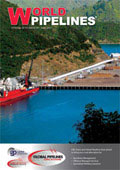Editorial comment
All eyes have been on central Asia recently, and the mix of pipeline projects planned to bring Caspian energy to the West.
Register for free »
Get started now for absolutely FREE, no credit card required.
All eyes have been on central Asia recently, and the mix of pipeline projects planned to bring Caspian energy to the West. The vast natural reserves that reside in the region impart to their respective owners some serious strategical power. Rivalry between the West and Russia over access and shipping deals has brought the proposed Nabucco pipeline in particular into the spotlight.
Construction of the EU-endorsed Nabucco pipeline, a E7.9 billion project to transport gas from Turkey to Austria via Bulgaria, Romania and Hungary is scheduled to begin in 2011, with first deliveries in 2014. Designed to reduce Western dependency on Russian gas, the project has been beset by problems, financial and otherwise. Despite US backing and a consortium headed by OMV and including MOL, Botas, Bulgargaz, Transgaz and RWE, doubts still linger about the total costs of the long-delayed project, the stability of the transit countries and where exactly the gas will come from.
As I write, Turkmenistan is preparing to host an international energy security conference, to which US, EU and Russian envoys are being dispatched. EU-Russian tensions may well be in evidence at the meeting, following the recent announcement that Turkmenistan has signed an agreement with RWE, giving the German energy company exploration rights and long-term delivery contracts to Europe. RWE says that a number of transit options are being considered, but that the Turkmen gas could be fed into the existing South Caucasus Gas Pipeline, or others planned, and from there into Turkey, joining the Nabucco pipeline. This is a major deal for RWE, the Nabucco consortium member. It also sends a message to Russia that Turkmenistan, which is believed to hold massive gas reserves beneath its mostly desert territory, is capable of making its own energy deals. Russia holds a nearmonopoly on Turkmen exports and has used Turkmen gas to shore up its own declining domestic production. A recent blast at a key Turkmen-Russian pipeline section last month has not helped relations between the two neighbours, already strained by an ongoing dispute over a cut in Russian gas purchases.
Meanwhile, as Turkmenistan takes small steps in one direction, away from its powerful neighbour, Azerbaijan announced this week that it wants Russia to serve as a transit route for Azeri gas bound for Europe. Azeri President Ilham Aliyev has spoken about the impending agreement, which would see Gazprom exporting Shah Deniz gas from next year. A deal between the two countries would be a blow to the Nabucco Consortium, which has sought to deal with the Caspian member states directly.
Russia’s interests lie within the proposed South Stream pipeline, a rival to Nabucco, in which Gazprom and Eni would transport gas under the Black Sea in a E10 billion pipe to southeast Europe, bypassing Ukraine.
The US has strategic interests in the Nabucco pipeline, and has promoted this pipeline over others in the region. President Barack Obama visited Ankara in early April and encouraged Turkey in its aspirations to become an energy hub for Europe’s imports. Turkey sits at a crucial spot between East and West and, as such, would be a key ally for the US in the issue of energy security, especially in the light of US concerns over Iran. In receiving this US stamp of approval, Turkey is in a position to pursue trade co-operation with the US in return for its role as a safe energy transit point for Europe. The project may also improve Turkey’s bid to join the EU.
In an interesting twist to the saga, under the new leadership of President Obama the US government may be shifting policies and looking at improving its relations with Moscow. Alexander Rar, Director of Russia and CIS Programmes for the Foreign Policy Council of Germany, said in a roundtable discussion for a Russian oil magazine, that “Americans offered to unite South Stream, Nabucco and other pipes into a general project under the code name of ‘Southern Corridor’ in order not to create geopolitical contradiction at a time when we need Russia to solve [the] Iranian problem”.
This rebranding, which may also be adopted by western European governments, would seek to bunch potentially competitive projects into one package. Here it fails to recognise the geopolitical complexities and delicate international relations that support or hinder each of the pipelines as they struggle to become a reality. It’s getting rather crowded in the Southern Corridor.


